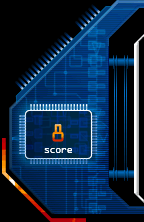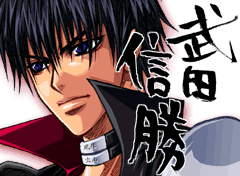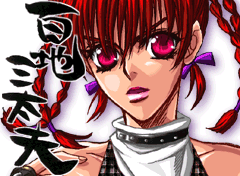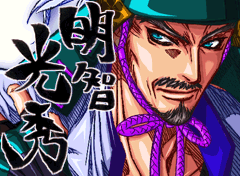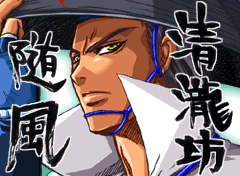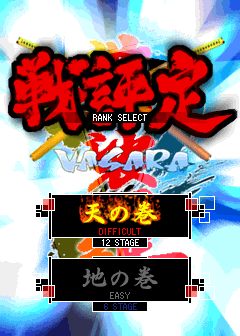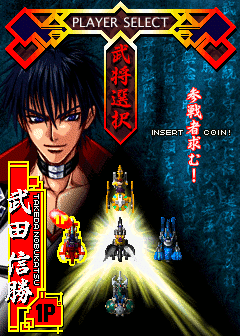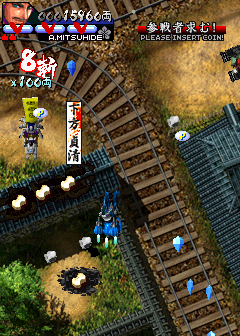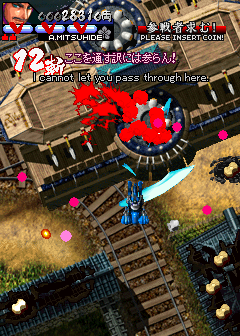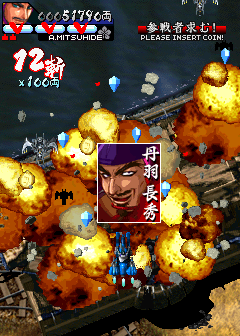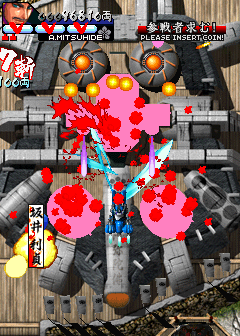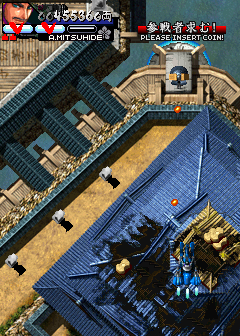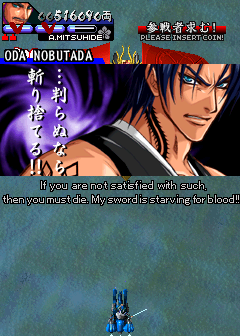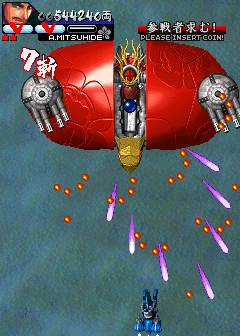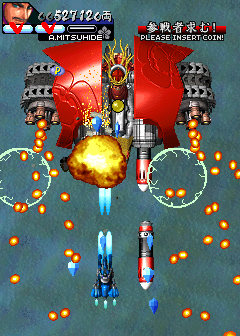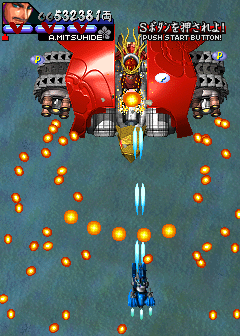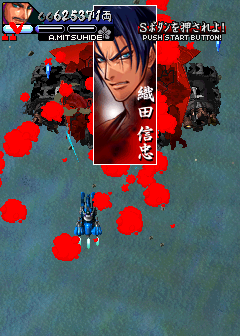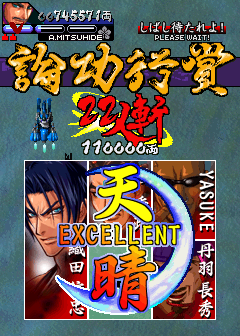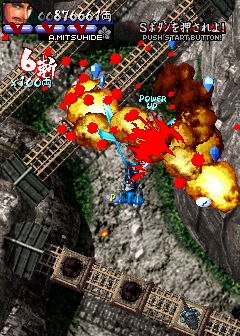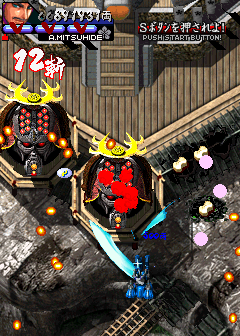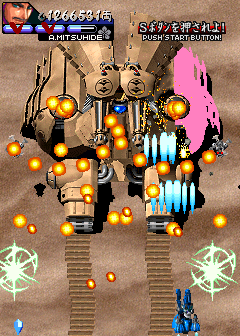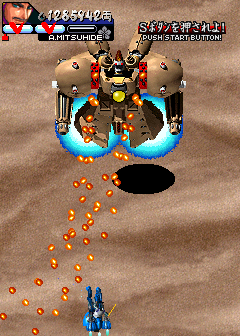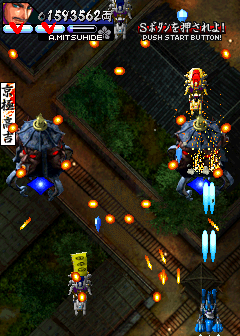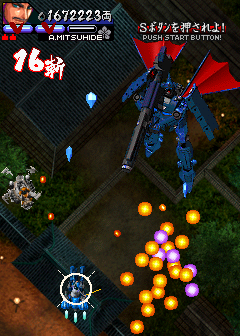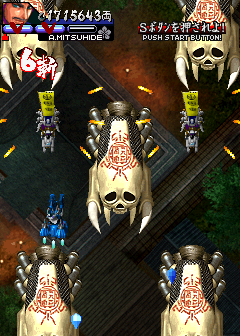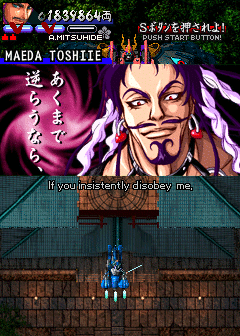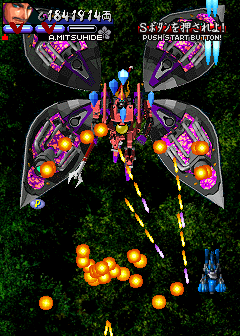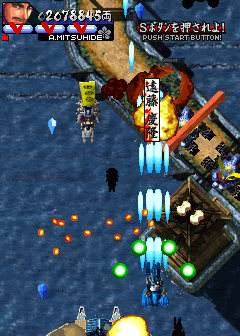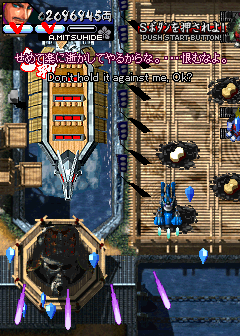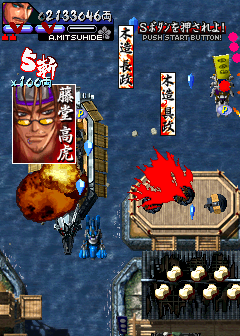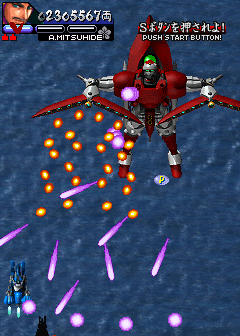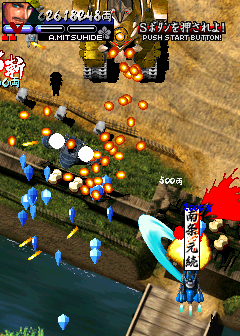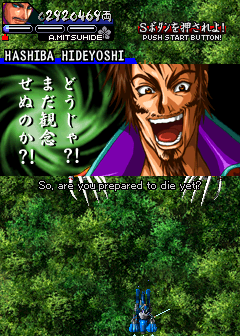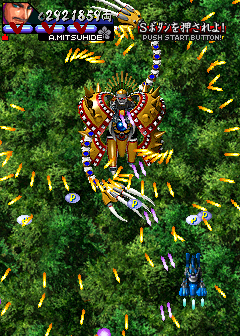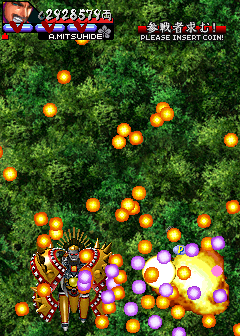      |
|
|
Seven Samurai >> ...actually applies this time, provided you add in the cast from the Vasara. And ignore the hidden character. |
<< Serect Difficurty Right off the bat you'll be asked to choose between the two difficulty levels: "Easy" (one loop) and "Difficult" (two loops). Of course, seeing as this is a manic shooter the words "easy" and "difficult" tend to be very relative.
|
Feudal Japanese Railway >> ...is a mini-boss, announcing his presence. There's more of them compared to the first Vasara, plus you need to defeat them more quickly since they're liable to leave if you dawdle. |
<< Quick Explanation The first four stages of the game are arranged in a different order depending on which character you choose, with this one being a moderately-sized ground fortress that segues into several hovering fortresses. To the left are some gold bars ripe for medaling, a named enemy, his dead buddy's banner and the beginning of the cumulative score counter. On the right are the little blue gems that pop out of defeated enemies (PROTIP: melee attacks cause enemies to drop more of them) and straight ahead...
|
Purple Shots >> The first appearance of the soon-to-be-cursed indestructible purple bullets. Granted, they're not that bad right now, but just wait. |
<< Perfect for Framing ...and after he's beaten you get a signed 8" by 10" glossy! Collect the whole set!
|
Introductions >> At the end of the stage there is, naturally, a boss. In this instance it's Oda Nobutada, eldest son of Oda Nobunaga. After his father disappeared into the Honnouji temple, he fled to Nijo Castle and, after it was besieged by Mitsuhide, committed suicide. You ever hear of "suicide by cop?" This's suicide by warlord. |
<< Bling-Bling Right after the fourth mini-boss, blast the roof of the pagoda to reveal two stacks of gold bars. Yeah, there's only one there, but uh... well, the thing is that they're actually chocolate and I kinda got hungry, so...
|
Familiar >> Yeah, didn't I see something like this in DoDonPachi? The bullet spreads, the giant missiles... fortunately it's a lot easier to survive, as you can shoot down the missiles fairly easily with no harm to yourself, or just fly right up between them and start slashing the boss if you're feeling lucky. |
<< Assault In the beginning his attacks consist of four-round shots with the side turrets at fixed intervals and tight aimed spreads from the center thrown in at a different pattern, with a purple spread every so often to throw you off (the shots are slow and telegraphed a bit, though). After you shoot off the turrets on the sides he busts out the gatling guns and missiles.
|
Bleeding Robots >> ...and you get a nice big wall scroll-ish deal when you beat him, along with gratuitous amouts of blood splattering on your screen. They do leave if you don't beat them fast enough though, so don't think that you can dawdle scraping bullets all day. |
<< Onslaught After he gets low on life he just drops all pretense of form and simply begins spamming you with bullets. Believe it or not, due to the way his gatling shots spread your best bet is to get close to him and use your melee attack whenever he fires from the center.
|
Hack the Rockies >> Hey, coming up with taglines for these pictures is hard. Anyway, the second of the four stages goes through a mountain range, complete with mine entrances and what may be the spiritual ancestor of those railway turrets you see all over the place in other games. |
<< Tally In each stage there's eighteen named enemies, four mini-bosses and a general at the end, with a total possible bonus of 150,000 points for shooting them all down. Not too shabby.
|
Boss Time >> Eventually it levels off into a sandy plateau and Shibata Katsuie makes an appearance. His history is long and boring so I won't cover it here. What I will cover is his attacks. Namely, he drops drone ships from those pods on the side and spams the screen with fixed spreads and the occasional sloppy semi-random aimed shot. Nothing fast, so dodging shouldn't be a major issue unless you're uncoordinated (like me). |
<< Samurai Heads Oh, and samurai head-shaped turrets. What is it with Vasara and samurai head-shaped turrets, anyway?
|
Lantern Heads >> Stage the third takes you over a town at night, which would be pretty nice were it not for those flying rotating lantern heads spewing bullets everywhere. They're really durable, too. |
<< Robot Time After dishing out enough damage the sandcrawler turns into a flying robot (of course) with a fixed attack pattern: Fixed purple spreads from the hands, aimed wide spread, a long stream of aimed shots (shown), an aimed spread to either side of your ship, a wide fixed bullet spam and another aimed spread to either side. It's not too bad in the beginning but the weaker he gets the faster he goes, turning those shots to the side into flying walls.
|
Skull Ship >> ...and eventually a fleet of these things comes flying overhead. Odds are you won't be able to destroy them so you're better off not even trying. Really, the only purpose they serve is to block off parts of the screen and distract you as the small fry come in and shoot at you... which makes them a lot more dangerous. |
<< Feudal Armor Double Zeta? This is exactly what I'm talking about when I say that in later stages bosses start tossing purple shots in with their regular spreads. Once you get used to cutting through their shots... WHAM.
|
Stupid Bullet Tricks >> After dealing enough damage, he opens up the butterfly wing-like things on the sides and starts pulling stuff like shooting streams of orange bullets with purples on the tips. This wouldn't be half an issue were it not for all those big, slow, random spams he tosses out. Curiously enough, he doesn't use his spear a whole lot. Not that I'm complaining, mind you... |
<< "So GAY! For YOU!" Uh... yeah. So anyway, Toshiie here is pretty fond of radial bullet sprays, trapping you in streams of bullets and shooting purple shots at you every so often. Nothing ridiculously difficult, mind you. That comes later.
|
Familiar? >> Hey, isn't that ship...? |
<< Deja Vu The last of the four stages (provided that you play them in that order) takes you over and through a seaside fortification which bears an interesting resemblance to the one from the first Vasara, right down to the music.
|
Lobster Sticks to Robot >> The giant flying crustacean at the end of the stage is piloted by Takigawa Kazumasu, loyal Oda general with a very spotty win/loss record. His MO is fairly simple: bullet spam. After you destroy both claws, his MO changes to purple bullet spam, with him firing curtains of shots from both of those smaller claws. This is basically the point in the game where things start getting ridiculous. |
<< Crazy Prequel-Sequel Stuff ...yup, he's a boss in the first Vasara. Apparently doesn't die when you explode his ship in a shower of blood. Go figure.
|
Minkey Leesance >> Hashiba Hideyoshi, AKA Toyotomi Hideyoshi, AKA "monkey." He did eventually unify Japan after Nobunaga died, but that's not as interesting as the fact that he had two thumbs on his right hand. I could try and sum up his attack patterns, but I think that it's just easier... |
<< The Hidden Fortress After the initial four stages it's off to a military encampment in the middle of a forest. As previously stated, things start getting ridiculous from here.
|
... >> ...what kind of crazy BS you'll be put through. Oh, and all those bullets are floating very, very slowly, plus the boss bounces around the screen which tends to smack you into the bullets and, well... you get the idea. |
<< ... ...to show you...
|
|
TOP | HOME  www.shmups.com © 1997 - 2010 Malcolm Laurie |
